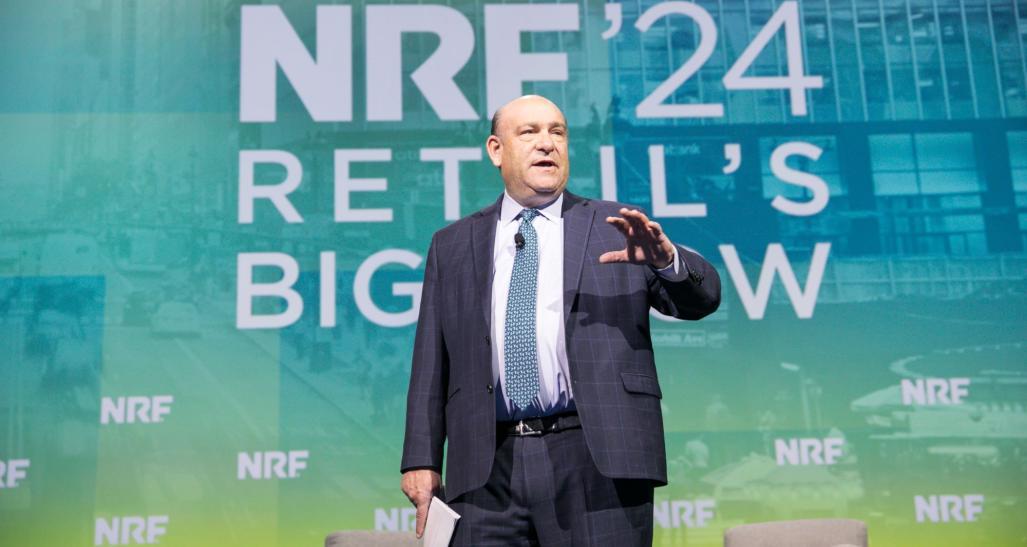
Steve Liesman, senior economics reporter at CNBC, speaks at NRF 2024: Retail's Big Show.
For anyone simply needing to hear that things are going to be OK financially, CNBC senior economics reporter Steve Liesman delivered at NRF 2024: Retail’s Big Show.
“You don’t have to load up on cans of tuna and go into your basement,” Liesman said in a keynote session. “I think the economy is going to grow relatively slowly this year, slower than it’s been, but I don’t think a recession is in the cards. I’m going to give that away right off the bat.”
Liesman elaborated on the idea of “living through the recession that never happened that everybody was sure was coming,” but not before sharing an anecdote from the book, “Against the Gods: The Remarkable Story of Risk,” by Peter L. Bernstein.
He told the tale of Kenneth Arrow, who would later go on to win the Nobel Prize in economics. During World War II, Arrow worked in the weather forecasting department for the U.S. Army. The commanding general decided that a long-range forecasting unit was needed, even though relatively little was known about predicting the weather.
The long-range forecasts were terrible, and Arrow and his cohorts petitioned the commanding general to return to short-term forecasts, so they might actually do some good. They heard back, as the story goes, that there was awareness that the long-range forecasts were useless – but they were still required for planning purposes.
“Everybody is super hungry to know what the future is,” Liesman said. “And we do a sometimes-terrible job at forecasting it, as I’m going to show you.”
Liesman ran through a variety of charts showing why many believed recession was probable in this season; it has been a “really extraordinary” time, he said. Inflation has been declining, but growth has been above potential. Consumers — and retailers — “really kept us going,” he said.
“Consumers found a way to maintain their inflation-adjusted level of spending despite prices being higher. It had a lot to do with government assistance. It had a lot to do with wages being higher and, of course, very low unemployment. All of that was part of it.”
But he’s going to have to stop making these charts, he said, because of the “tidal wave” in the middle thanks to COVID-related decline and rebound.
It’s essential to understand that tidal wave to understand the economy. Liesman likened it to visiting an island that had just been through a hurricane, and trying to understand why all the trees are down, houses are wrecked, and new houses are being built, without knowing there was a storm.
He talked about the double-digit inflation of decades past. “You cannot understand the Federal Reserve, and what motivates them today, without looking at that chart,” he said. There was inflation, the Fed eased back on interest rates, then there was an oil embargo and inflation came back.
There’s another more recent “peak” on that chart, “and the reason the Fed may or may not be cutting interest rates in the next several months is because they’re deathly afraid of peak number two.” When the Fed hikes interest rates, recession follows.
“That was part of the reason why economists on the street were pretty darn sure we were going to have a recession this year, because it happens all the time.” The expectation this year, however, is that interest rates are going to come down, certainly on a short-term basis.
Liesman touched on jobs, gains in the advancement of productivity, and unemployment. The unemployment rate has not responded to the rising interest rates, as it historically does. “It may yet happen,” he said. “But there are reasons to think it might not.”
The pandemic complicated the picture with a decline in the labor force thanks to accelerated retirements, deaths and other reasons. It’s been coming back, but not to where it was previously. The lack of labor brings concerns about the possibility of “labor hoarding,” where companies will hold on to workers beyond their need for those workers, potentially bringing a faster rise in the unemployment rate if there is a slowdown.
Liesman also touted the CNBC/NRF Retail Monitor, powered by Affinity Solutions. It leverages anonymized data from more than 140 million credit and debit cards, tracking close to 9 billion transactions to measure monthly and annual changes in U.S. retail sales. More data means better forecasting, and the insights are available to NRF members through the website.